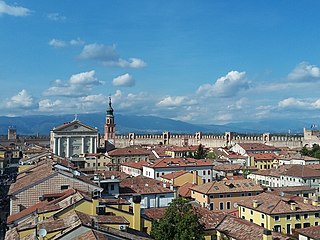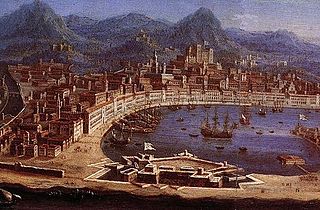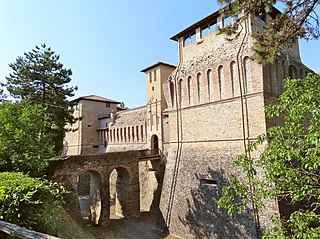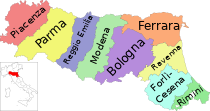
The Duchy of Parma and Piacenza was an Italian state created in 1545 and located in northern Italy, in the current region of Emilia-Romagna.

Pier Luigi Farnese was the first Duke of Castro from 1537 to 1545 and the first Duke of Parma and Piacenza from 1545 to 1547. He was the eldest of the three natural sons of Cardinal Alessandro Farnese (1468-1549) and was legitimated in 1505. He was a notable soldier and participated in the Sack of Rome in 1527.

Ranuccio I Farnese reigned as Duke of Parma, Piacenza and Castro from 1592. A firm believer in absolute monarchy, Ranuccio, in 1594, centralised the administration of Parma and Piacenza, thus rescinding the nobles' hitherto vast prerogative. He is best remembered for the "Great Justice" of 1612, which saw the executions of a large number of Piacentine nobles suspected of plotting against him. Claudia Colla his mistress and her mother were accused of using witchcraft to stop him from having offspring, and both were sentenced to death by burning. Because one of the conspirators, Gianfrancesco Sanvitale, falsely implicated several Italian princes, namely Vincenzo Gonzaga, Duke of Mantua and Cesare d'Este, Duke of Modena, in the plot, Vincenzo and Cesare's names appeared on the list of conspirators during formal court proceedings; as a result, Ranuccio's reputation among the rulers of Italy was irreparably damaged because it was evident that he gave credence to Gianfrancesco's obviously false confession. When, consequently, in the early 1620s, Ranuccio was looking for a bride for his younger legitimate son and heir, Odoardo, none of the Italian ruling families were forthcoming with princesses.

Ranuccio II Farnese was the sixth Duke of Parma and Piacenza from 1646 until his death nearly 50 years later and Duke of Castro from 1646 until 1649.

The House of Farnese was an influential family in Renaissance Italy. The titles of Duke of Parma and Piacenza and Duke of Castro were held by various members of the family.

Kastellet is a citadel located in Copenhagen, Denmark. It is one of the best preserved fortresses in Northern Europe. It is constructed in the form of a pentagon with bastions at its corners. Kastellet was continuous with the ring of bastioned ramparts which used to encircle Copenhagen but of which only the ramparts of Christianshavn remain today.

Cittadella is a medieval walled city in the province of Padua, northern Italy, founded in the 13th century as a military outpost of Padua. The surrounding wall has been restored and is 1,461 metres (4,793 ft) in circumference with a diameter of around 450 metres (1,480 ft). There are four gates which roughly correspond the points of the compass.

The Citadel, also known as the Castello, is the citadel of Victoria on the island of Gozo, Malta. The area has been inhabited since the Bronze Age, and the site now occupied by the Cittadella is believed to have been the acropolis of the Punic-Roman city of Gaulos or Glauconis Civitas.

The Shrine of Santa Maria della Steccata is a Greek-cross design Renaissance church in central Parma, Italy. The name derives from the fence in the church. A Nursing Madonna is enshrined within, crowned on 27 May 1601 by a Marian devotee, Fray Giacomo di Forli of the Capuchin order. Pope Benedict XVI raised the Marian sanctuary to the status of Basilica minor on 9 February 2008.
The Triangula Bastion was part of the 18th-century fortifications of Riga. Its foundations are nowadays visible under a modern office building owned by Euro Live Technologies a playtech company.

The walls of Genoa constitute in their whole the several circles of walls that protected and defended the city of Genoa, former capital of the homonymous republic. To this day, large portions of these walls remain, and Genoa has more and longer walls than any other city in Italy.

Santa Maria degli Angeli is a church in central Parma. It is also called Santa Maria dell'Addolorata or Santa Maria del Bambin Gesù.

The Citadel of Liège was the central fortification of the strategic Belgian city of Liège, Wallonia, until the end of the 19th century. It is located in the Sainte-Walburge neighborhood, 111 metres (364 ft) above the Meuse valley. Together with Dinant, Huy and Namur, the Citadel of Liège forms part of the so-called Meuse Citadels.

Siena’s Fortezza Medicea is a fort built in the city between 1561 and 1563 on the orders of Duke Cosimo, a few years before he became the first Grand Duke of Tuscany.

The Cittadella of Alessandria is a star fort and citadel in the city of Alessandria, Italy. It was built in the 18th century by the Kingdom of Sardinia, and today it is one of the best preserved fortifications of that era. It is one of the few fortifications in Europe still in their original environment, since there are no buildings blocking the views of the ramparts, or a road that surrounds the ditches.

The New Fortress of Corfu is a Venetian fortress built on the hill of St. Mark in Corfu in stages. The original architect of the fort was the military engineer Ferrante Vitelli. The current buildings which exist within the fortress were built by the British during their rule of the island (1815–63).

The Real Cittadella was a fort in Messina, Sicily. The Cittadella was built between 1680 and 1686 by the Spanish Empire, and it was considered to be one of the most important fortifications in the Mediterranean. Most of the fort was demolished in the 20th century, but some parts can still be seen.

The Castello or Castle of Felino is a moated castle in a forested grove near the town of Felino, province of Parma, region of Emilia Romagna, Italy.

Porta Nuova is a gateway to the historic center of Verona, built between 1532 and 1540. It was designed by architect Michele Sanmicheli. Giorgio Vasari said of the gateway in Le vite de' più eccellenti pittori, scultori e architettori "never before any other work of more grandeur or better design."



























